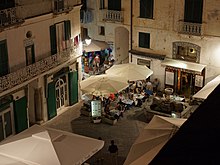Atrani
| Atrani | ||
|---|---|---|

|
|
|
| Country | Italy | |
| region | Campania | |
| province | Salerno (SA) | |
| Coordinates | 40 ° 38 ' N , 14 ° 36' E | |
| surface | 0.20 km² | |
| Residents | 837 (Dec. 31, 2019) | |
| Population density | 4,185 inhabitants / km² | |
| Post Code | 84010 | |
| prefix | 089 | |
| ISTAT number | 065011 | |
| Patron saint | Santa Maria Maddalena (July 22nd, 3rd Sunday in October) | |
 Panorama of Atrani |
||
Atrani is an Italian municipality on the Amalfi Coast in the province of Salerno in Campania . She is a member of the association I borghi più belli d'Italia (The Most Beautiful Places in Italy) .
geography
The place is about a kilometer east of Amalfi in a small bay at the mouth of the Dragone stream . The city and the beach form a kind of natural theater that opens onto the sea. The Monte Aureo is considered a landmark above the city. Since the dissolution of the municipality of Fiera di Primiero ( Province of Trento ) on January 1, 2016, Atrani has been the smallest municipality in Italy in terms of area. State Road 163 runs along the coast.
history
In the Middle Ages , Atrani was part of the Maritime Republic of Amalfi. The sea trade had also led to economic growth in this place, which made some merchants very wealthy. They had their residences and palaces built here. According to tradition, the Doges of the Maritime Republic were crowned in the Cathedral of San Salvatore de 'Bireto . The cathedral was completed by 1087 at the request of the first bishop of Ravello . At the end of the 12th century it was redesigned for the first time and received a bronze portal cast in Constantinople based on artistic models by Barisano da Trani . In 1272 a marble pulpit adorned with lions was installed. In 1980 an earthquake severely damaged the church. Restoration work began in the 1990s.
Today the inhabitants have partly switched to gentle tourism as a branch of business, there are only a few small accommodations. The city was almost able to retain its original character. Because of the steep slope and the many stairs there is almost no car traffic. Hiking trails lead from Atrani on the steep stairways typical of the region to Ravello and along the coast to Castiglione del Genovesi and Minori .
Attractions
- The Piazza Umberto I. is the center of the place.
- The church of San Salvatore de 'Bireto (built in the 10th century, converted to Baroque style in 1810) is the former coronation church of the Doges of Amalfi, located directly on Piazza Umberto I.
- The church of Santa Maria Maddalena (built in the 13th century, redesigned in Baroque style in 1771) with its characteristic majolica dome is dedicated to St. Mary Magdalene , who is the local patroness. Their festival is celebrated every year on July 22nd.
People related to the place
- The Dutch graphic artist MC Escher (1898–1972) used Atrani, in particular a church located on a protruding rock, several times in his pictures.
- The German writer and philosopher Walter Benjamin (1892–1940), who visited the Amalfi Coast in 1924, dedicated a small literary travel picture to the place
literature
- Walter Benjamin: Atrani . In: ders., One-way street , in: Gesammelte Schriften Vol. IV, 1, Suhrkamp, Frankfurt am Main 1972, p. 122.
Web links
Individual evidence
- ↑ Statistiche demografiche ISTAT. Monthly population statistics of the Istituto Nazionale di Statistica , as of December 31 of 2019.
- ^ I borghi più belli d'Italia. Borghipiubelliditalia.it, accessed September 9, 2017 (Italian).
- ↑ a b Naples. Amalfi Coast. Cilento . Dumont Travel Paperback, ISBN 978-3-7701-7241-2 ; Page 223ff



